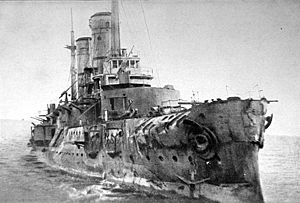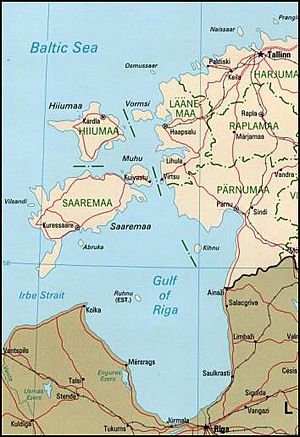Battle of Moon Sound facts for kids
Quick facts for kids Battle of Moon Sound |
|||||||
|---|---|---|---|---|---|---|---|
| Part of Eastern Front (World War I) | |||||||
 The Russian pre-dreadnought Slava crippled by German fire off Saaremaa, 17 October 1917. |
|||||||
|
|||||||
| Belligerents | |||||||
| Commanders and leaders | |||||||
| Strength | |||||||
| 1 battlecruiser 10 battleships 9 light cruisers 1 mine cruiser 50 destroyers 6 submarines |
2 pre-dreadnought battleships 3 cruisers 3 gunboats 21 destroyers 3 submarines |
||||||
| Casualties and losses | |||||||
| 156 killed 60 wounded 2 dreadnoughts damaged 1 torpedo boat sunk 7 minesweepers sunk various other ships damaged |
unknown number of casualties 1 pre-dreadnought heavily damaged and scuttled 1 destroyer sunk 1 submarine sunk minor damages |
||||||
The Battle of Moon Sound was a big naval battle during World War I. It happened in the Baltic Sea from October 16 to November 3, 1917. The fight was between the German Empire and Russian Republic forces. Three British submarines also joined the Russian side.
Germany wanted to destroy the Russian navy in the area. They also aimed to take over the West Estonian Archipelago. This group of islands includes Saaremaa, Hiiumaa, and Muhu. The German navy was much stronger. They had many battleships and cruisers. Russia had fewer, older ships.
Contents
Why the Battle Happened
The Germans wanted to take control of the West Estonian Archipelago. They started an operation called Operation Albion in September 1917. They quickly captured the main islands like Saaremaa, Hiiumaa, and Muhu.
This left a group of Russian ships trapped. These ships were in the Gulf of Riga. They included older battleships like Grazhdanin and Slava. These ships were from the Russo-Japanese War era. There were also some cruisers and destroyers.
On October 17, 1917, the Russian ships managed to escape. They sailed through the Suur Strait. This strait separates Muhu island from the Estonian mainland. Many Russian sailors were unhappy with the war. They wanted peace. But they also didn't want the Germans to capture Petrograd. Petrograd was a very important city for the revolution happening in Russia.
The Battle Begins
When the battle started, two British submarines were in the Gulf of Riga. These were C 27 and C 32. Another submarine, C 26, was sent later. On the night of October 16, C 27 fired torpedoes at German ships. Two of them hit their targets.
German forces made good progress on land that day. They captured many Russian soldiers and guns. By the end of October 16, the Germans were ready to attack the islands. Their navy was prepared to move into Matsalu Bay and the Suur Strait.
Fighting on October 17
The Russian battle plan changed early on October 17. This was due to a mistake in an order. By 7:00 AM, ships were moving. Russian battleships started firing at German ships around 7:20 AM. The Germans were trying to clear mines.
Around 8:00 AM, German Admiral Behncke ordered his cruisers to stop. But two powerful German battleships, König and Kronprinz, moved forward. The Russian battleship Slava also moved and began firing at German ships.
By 9:10 AM, Russian ships fired on German minesweepers. The Russians knew that stopping the minesweepers would stop the whole German attack. By 10:00 AM, the German minesweepers reached the edge of the minefield.
Then, the battleships König and Kronprinz moved ahead. Around 10:13 AM, König fired at Slava. Kronprinz then fired at the battleship Grazhdanin. Slava was hit many times underwater. It was badly damaged. Grazhdanin was only hit twice.
At 10:40 AM, the Germans stopped firing. The Russians kept firing at the minesweepers. Around 10:30 AM, Russian Admiral Bachirev ordered all ships to retreat. The Slava was too damaged to be repaired. It was sunk on purpose by the Russians. They wanted to block the channel with the damaged ship. They also laid more mines to stop the Germans.
Later that day, German ships were fired upon by a Russian battery. Two German battleships anchored under fire. There were also false and real submarine alarms.
In the afternoon, the German light cruiser Kolberg attacked Võilaid. German landing parties took over Woi. By 3:00 PM, German ships tried to enter the Suur Strait. But they were immediately fired upon by Russian gunboats.
By 10:00 PM, German torpedo boats moved into the Suur Strait. By the end of the day, Germans controlled the southern Suur Strait. They also controlled the Väike Strait and Matsalu Bay. The Russians gave up trying to hold the Suur Strait.
Just after midnight on October 18, a German torpedo boat, S 64, hit a mine. It sank before 1:00 AM.
The Final Push
At dawn on October 18, German torpedo boats patrolled Matsalu Bay. German landing operations on Hiiumaa island gained speed. The area around Emmaste was secured. By 8:30 AM, German minesweepers had moved closer to the Viirelaid lighthouse.
Around 10:00 AM, Admiral Behncke sent the light cruiser Strassburg to join another German squadron. By 12:40 PM, the Germans confirmed that Slava had sunk. They also saw Russian destroyers laying mines. The Germans opened fire, and the Russians fired back.
Two German torpedo boats fired as they moved north. Russian gunboats and destroyers fired at them. The Russians then turned south quickly, hidden by a smokescreen. By the evening of October 18, the Germans had taken Saaremaa and Muhu islands. Kuressaare was made a supply base.
On October 19, the remaining Russian ships left the northern Suur Strait. They were protected by minesweepers and destroyers. By mid-afternoon, German forces had entered the strait.
What Happened After
The Battle of Moon Sound was a big German success. They destroyed Russian forces on the islands. They also took firm control of the islands and their coastal defenses. This defeat made the Russian military unwilling to fight more. Soon after, on November 7, the Bolsheviks took over the Russian government.
The Russians lost the destroyer Grom. The battleship Slava was sunk on purpose to block the channel. Most of the crews from these ships were saved. Other Russian ships had minor damage. The rest of the Russian fleet escaped to Finland. Bad weather and minefields stopped the German fleet from catching them.
The Germans had more casualties. 156 soldiers were killed, and 60 were wounded. They lost more ships, mostly small torpedo boats. The S 64 hit a mine and sank. Before the battle, two German ships were sunk by mines. Two more were damaged. During the battle, other ships were sunk by mines. The battleships Bayern and Grosser Kurfürst were damaged by mines. The battleship Kronprinz ran aground on its way back. It took months to repair.
See also
- Operation Albion
- Moonsund Landing Operation (1944)


